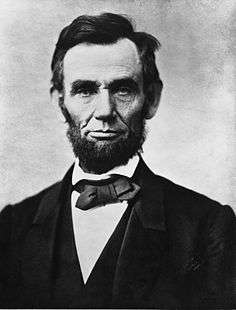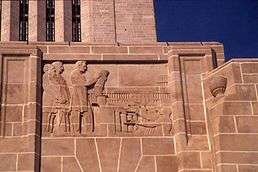Memorials to Abraham Lincoln
| ||
|---|---|---|
|
President of the United States First term Second term Assassination and legacy
|
||
Abraham Lincoln, U.S. president 1861–65, has been memorialized in many town, city, and county names,[1] Along with George Washington, he is an iconic image of American democracy and nationalism.
Changing image
Barry Schwartz, a sociologist who has examined America's cultural memory, states that in the 1930s and 1940s, the memory of Abraham Lincoln was practically sacred and provided the nation with "a moral symbol inspiring and guiding American life." During the Great Depression, he asays, Lincoln served "as a means for seeing the world's disappointments, for making its sufferings not so much explicable as meaningful." Franklin D. Roosevelt, preparing America for war, used the words of the Civil War president to clarify the threat posed by Germany and Japan. Americans asked, "What would Lincoln do?"[2] However, he also finds that since World War II, Lincoln's symbolic power has lost relevance, and this "fading hero is symptomatic of fading confidence in national greatness."[3] He suggested that postmodernism and multiculturalism have diluted greatness as a concept.
While Lincoln remains in the very top tier of presidential rankings, all of the presidents have slipped in historical prestige in the public's mind. Schwartz said the reason is what he calls the "acids of equality": as American culture became more diverse, egalitarian, and multicultural, it also suffered a "deterioration and coarsening of traditional symbols and practices."[4]
Lincoln sites remain popular tourist attractions, but crowds have thinned. In the late 1960s, 650,000 people a year visited the home in Springfield, slipping to 393,000 in 2000–2003. Likewise visits to New Salem fell by half, probably because of the enormous draw of the new museum in Springfield. Visits to the Lincoln Memorial in Washington peaked at 4.3 million in 1987 and have since declined. However crowds at Ford's Theatre in Washington have grown sharply.[5]
Organizations
The oldest continuously-operating association in the United States honoring Lincoln is the Lincoln Association of Jersey City in Jersey City, New Jersey, which was formed in 1865 shortly after Lincoln's assassination. The Association has held a banquet in Jersey City every year on Lincoln's birthday, February 12. The Association has been addressed by a number of people of national importance, including political figures, military veterans, educators and civil rights leaders. The Association celebrated its 150th anniversary on February 12, 2015, which included the laying of a wreath at the entrance to Jersey City's Lincoln Park. The Association's annual dinner featured speaker Todd Brewster, author of Lincoln's Gamble, about the struggle to create the Emancipation Proclamation.[6]
Memorials
The memorials include the name of the capital of Nebraska. The first public monument to Abraham Lincoln, after his death, was a statue erected in front of the District of Columbia City Hall in 1868, three years after his assassination.[7]
The first national memorial to Abraham Lincoln was the historic Lincoln Highway, the first road for the automobile across the United States of America, which was dedicated in 1913, predating the 1921 dedication of the Lincoln Memorial in Washington D.C. by nine years.
Lincoln's name and image appear in numerous other places, such as the Lincoln Memorial in Washington, D.C. and Lincoln's sculpture on Mount Rushmore, Abraham Lincoln Birthplace National Historical Park in Hodgenville, Kentucky,[8] Lincoln Boyhood National Memorial in Lincoln City, Indiana,[9] Lincoln's New Salem, Illinois,[10] and Lincoln Home National Historic Site in Springfield, Illinois[11] commemorate the president.[12] The Lincoln Memorial at Louisville Waterfront Park features a double-life-size sculpture of a seated, hatless Lincoln surrounded by narrative bas relief sculptures by Edward Hamilton which depict the history of slavery as witnessed by Lincoln in the slave markets of Kentucky.[13]
Ford's Theatre and Petersen House (where he died) are maintained as museums, as is the Abraham Lincoln Presidential Library and Museum, located in Springfield.[14][15] The Lincoln Tomb in Oak Ridge Cemetery in Springfield, Illinois, contains his remains and those of his wife Mary and three of his four sons, Edward, William, and Thomas.[16] Springfield's airport is named for him, the Abraham Lincoln Capital Airport.[17]
There was also the Great Moments with Mr. Lincoln exhibit in Disneyland, and the Hall of Presidents exhibit at Walt Disney World, which was based on Walt Disney admiring Lincoln ever since he was a little boy.
-
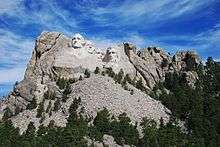
Mount Rushmore, showing the full size of the mountain and the scree of rocks from the sculpting and construction.
Desecration
On the night of November 7, 1876, a group of counterfeiters entered Lincoln's tomb with the intent of absconding with his mortal remains and holding them for ransom in order to secure the release of their leader, Benjamin Boyd, an imprisoned engraver of counterfeit currency plates. The group entered his tomb, but had only succeeded in partially dislodging its marble lid before a US Secret Service agent who had infiltrated their number alerted law enforcement authorities. Although several escaped, most served a one-year prison term. For much of the next decade (c. 1876 – 1887), Lincoln's tomb was mobile, to avoid further unwanted disinterment.[18]
Stamps, currency and coins
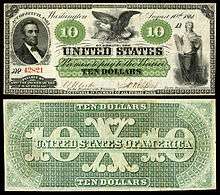
Within a year of this death, Lincoln's image began to be disseminated throughout the world on stamps.[19] Pictured on many United States postage stamps, Lincoln is the only U.S. President to appear on a U.S. airmail stamp.[20]
Lincoln was one of five people to be depicted on United States paper currency (federal issue) during their lifetime (along with Salmon P. Chase, Francis E. Spinner, Spencer M. Clark, and Winfield Scott). He has been featured on several denominations ($1, $5, $10, $20, $100, and $500) across different issues (e.g., Demand Notes, Legal Tender, Gold Certificates, Silver Certificates, etc.) since the first federally issued U.S. Bank Note in 1861.[21] In addition to the modern United States five-dollar bill, currency honoring the president includes the Lincoln cent, which represents the first regularly circulating U.S. coin to feature an actual person's image.[22]
Lincoln's image on the five-dollar bill was used by Salvador Dalí to help commemorate the U.S. Bicentennial with his creation of "Gala looking at the Mediterranean Sea which at a distance of 20 meters is transformed into the portrait of Abraham Lincoln (Homage to Rothko)" and Lincoln in Dalivision, the earlier of which was displayed at The Guggenheim in New York during the 1976 Bicentennial.[23]
International
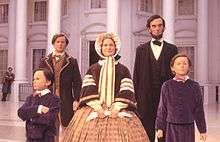
The first statue of Lincoln outside the United States was erected in Edinburgh, Scotland in 1893. The work of George Edwin Bissell, it stands on a memorial to Scots immigrants who enlisted with the Union during the Civil War, the only memorial to the war erected outside the United States. A second statue by George Grey Barnard was erected in Manchester, England in 1919. Nowadays situated in Lincoln Square south of Manchester Town Hall, the statue commemorates the impact the American Civil War had on the cotton cloth-producing region of Manchester and Lancashire.[24] A large statue of Lincoln standing by Saint Gaudens was unveiled near Westminster Abbey in London, on July 28, 1920, in an elaborate ceremony. The principal addresses were delivered in Central Hall, Westminster.[25] In 1964, United States President Lyndon Johnson presented a Saint Gaudens to the people of Mexico, which is displayed in Mexico City's Parque Lincoln.[26]
Birthday
Abraham Lincoln's birthday, February 12, was never a national holiday, but it was at one time observed by as many as 30 states.[1] In 1971, Presidents Day became a national holiday, combining Lincoln's and Washington's birthdays and replacing most states' celebration of his birthday.[27] The Abraham Lincoln Association was formed in 1908 to commemorate the centennial of Lincoln's birth.[28] In 2000, Congress established the Abraham Lincoln Bicentennial Commission to commemorate his 200th birthday in February 2009.[29]
Sculpture in the United States
- Abraham Lincoln, Lot Flannery, Washington, D.C. (1868)
- Abraham Lincoln, Vinnie Ream, United States Capitol rotunda, Washington, D.C. (1871)
- Lincoln Tomb, Larkin Goldsmith Mead, Springfield, Illinois (1874)
- Emancipation Memorial, Thomas Ball, Washington, D.C. (1876)
- Abraham Lincoln: The Man, aka Standing Lincoln, Augustus Saint Gaudens, Chicago, Illinois (1887)
- Abraham Lincoln: The Head of State aka Seated Lincoln, Augustus Saint Gaudens, Chicago, Illinois (1908)
- Abraham Lincoln, Adolph Alexander Weinman, Hodgenville, Kentucky (1909)
- Seated Lincoln, Gutzon Borglum, Newark, New Jersey (1911)
- Abraham Lincoln, Adolph Alexander Weinman, Kentucky State Capitol, Frankfort, Kentucky (1911),
- Standing Lincoln at the Nebraska State Capitol, Lincoln, Nebraska, Daniel Chester French (1912)
- Abraham Lincoln at The Pennsylvania State Memorial, J. Otto Schweizer, Gettysburg, Pennsylvania, (1913)
- Abraham Lincoln, George Grey Barnard, Cincinnati, Ohio (1917)
- Abraham Lincoln in the Lincoln Memorial, Daniel Chester French (1914–22)
- Abraham Lincoln, Civic Center, San Francisco, Haig Patigian (1926)
- Lincoln the Lawyer, Urbana, Illinois, Lorado Taft (1927)
- Abraham Lincoln, South Park Blocks, Portland, Oregon, George Fite Waters (1928)
- Mount Rushmore, Gutzon Borglum, (1927-1941)
- Lincoln Monument (Dixon, Illinois), Leonard Crunelle (1930)
- Emancipation Proclamation, Nebraska State Capitol, Lee Lawrie, Lincoln, Nebraska, (1932)
- Lincoln Trail State Memorial, Nellie Verne Walker, near Lawrenceville, Illinois, (1938)
- The Chicago Lincoln, aka Beardless Lincoln, Avard Fairbanks, Chicago, Illinois (1956)
- Lincoln Walks at Midnight, created by Fred Martin Torrey in 1933, cast by Bernard Wiepper, West Virginia State Capitol, (1974)
- "Young Abraham Lincoln", also known as "Abraham Lincoln on Horseback," "Abraham Lincoln Equestriam Monument," and "Abraham Lincoln on the Prairie", Anna Hyatt Huntington, editions located in Northwood Institute, Midland, Michigan, (1963): State University of New York, College of Environmental Science and Forestry, Syracuse, New York (1963): Salem State Park, Petersburg, Illinois, (1963–64): Lincoln City, Oregon, (1965):
Notes
- 1 2 Dennis, p. 194.
- ↑ Barry Schwartz, Abraham Lincoln in the Post-Heroic Era: History and Memory in Late Twentieth-Century America (2009) pp. xi, 9, 24
- ↑ Barry Schwartz, Abraham Lincoln in the Post-Heroic Era: History and Memory in Late Twentieth-Century America (2009) p. xi, 9
- ↑ Schwartz, (1990) p. 190.
- ↑ Schwartz (2009), pp. 153–155.
- ↑ "Lincoln Association of Jersey City marks 150th anniversary celebration year". The Union City Reporter. p. 14.
- ↑ "Renovation and Expansion of the Historic DC Courthouse" (PDF). DC Court of Appeals.
- ↑ "Abraham Lincoln Birthplace National Historic Site". U.S. National Park Service.
- ↑ "Lincoln Boyhood National Memorial". U.S. National Park Service.
- ↑ "Lincoln's New Salem". Illinois Historic Preservation Agency.
- ↑ "Lincoln Home National Historic Site". U.S. National Park Service.
- ↑ Peterson, pp. 312, 368,
- ↑ "Trees at Lincoln Memorial Site - on Newspapers.com". Newspapers.com (Indiana edition). Louisville Courier Journal. Newspapers.com. January 14, 2009. p. 5. Retrieved 11 July 2016.
- ↑ "The Abraham Lincoln Presidential Library and Museum". Abraham Lincoln Presidential Library and Museum. Archived from the original on 2011-10-25.
- ↑ "About Ford's". Ford's Theatre. Archived from the original on 2011-10-25.
- ↑ "Lincoln Tomb". Illinois Historic Preservation Agency. Archived from the original on 2011-10-25.
- ↑ "What's in an eponym? Celebrity airports - could there be a commercial benefit in naming?". Centre for Aviation.
- ↑ Keith Verinese. "The Adventures of Abraham Lincoln's Corpse". io9.comdate=April 5, 2012.
- ↑ Healey, Matthew. "Lincoln Stamps Bring Neary $2 Million at a New York Auction". The New York Times.
- ↑ William W. Cummings, and James B. Hatcher Scott Specialized Catalogue of United States Stamps (1982) p. 284.
- ↑ Portraits on U.S. Bank Notes : Abraham Lincoln (The National Currency Foundation), retrieved 28 December 2012
- ↑ Vinciguerra, Thomas (February 7, 2009). "Now if Only We Could Mint Lincoln Himself". The New York Times. p. WK4.
- ↑ "Lincoln in Dalivision".
- ↑ "Abraham Lincoln - Manchester". Manchester Art Galleries. Retrieved 2012-12-26.
- ↑ Twenty-Sixth Annual Report of the American Scenic and Historic Preservation Society, 1921 (Albany, NY: J. B. Lyon Company Printers, 1922), pp. 194–95.
- ↑ "Abraham Lincoln Coming to Cornish". nps.gov. February 13, 2015.
- ↑ Schwartz (2009), pp. 196–199.
- ↑ Peterson pp. 147, 263.
- ↑ Carroll, James R. (January 12, 2009). "Let the Lincoln Bicentennial Celebrations Begin". The Courier-Journal.
Further reading
- Burkhimer, Michael (2003). One Hundred Essential Lincoln Books. Cumberland House. ISBN 978-1-58182-369-1.
- Dennis, Matthew. Red, White, and Blue Letter Days: an American Calendar (2002).
- Gallagher, Gary. Causes Won, Lost, and Forgotten: How Hollywood and Popular Art Shape What We Know About the Civil War (2008) X served and text search
- Hogan, Jackie. Lincoln, Inc.: Selling the Sixteenth President in Contemporary America (2011) excerpt and text search
- Hufbauer, Benjamin. Presidential Temples: How Memorials and Libraries Shape Public Memory (2006)
- Neely, Mark. The Abraham Lincoln Encyclopedia (1984)
- Peterson, Merrill D. Lincoln in American Memory (1994), an encyclopedic catalogue of viewpoints
- Sandage, Scott A. "A Marble House Divided: The Lincoln Memorial, the Civil Rights Movement, and the Politics of Memory, 1939–1963," Journal of American History Vol. 80, No. 1 (Jun., 1993), pp. 135–167 in JSTOR
- Schuman, Howard; Corning, Amy; Schwartz, Barry. "Framing Variations and Collective Memory," Social Science History (2012) 36#4 pp 451–472.
- Schwartz, Barry. Abraham Lincoln and the Forge of National Memory (2000) excerpt and text search
- Schwartz, Barry. Abraham Lincoln in the Post-Heroic Era: History and Memory in Late Twentieth-Century America (2009) excerpt and text search
- Smith, Adam I.P. "The 'Cult' of Abraham Lincoln and the Strange Survival of Liberal England in the Era of the World Wars," Twentieth Century British History, (Dec 2010) 21#4 pp 486–509
- Spielberg, Steven; Goodwin, Doris Kearns; Kushner, Tony. "Mr. Lincoln Goes to Hollywood," Smithsonian (2012) 43#7 pp 46–53.
- Thomas, Christopher A. The Lincoln Memorial and American Life (2002)
